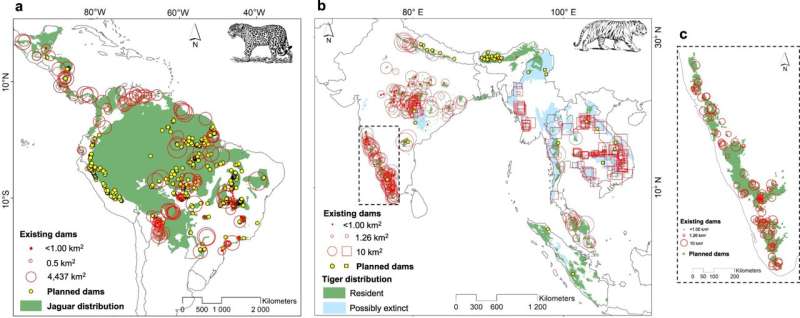December 10, 2021 report
The destructive impact of hydropower plants on jaguars and tiger habitats

A pair of researchers at Southern University of Science and Technology, in China has found that when hydroelectric power plants are built, tiger and jaguar habitats are lost, putting the cats at risk. In their paper published in the journal Communications Biology, Ana Filipa Palmeirim and Luke Gibson describe assessing the amount of habitat lost to hydropower and the impact it has on local wildcats.
Prior research has shown that big cats such as tigers and jaguars need huge swaths of land to survive. They travel around in their designated territory, hoping to keep their presence secret from their prey. Prior research has also shown that when hydroelectric dams are built, large areas of land are covered with water from reservoirs, and large areas of wildlife habitat are lost. The researchers suggest this is a problem for the big cats and note that tigers have been on the endangered list for many years and jaguars are listed as near threatened. Prior research has shown that tigers have disappeared from 93% of the range area where they used to live—there are just over 3,200 tigers left in the wild. And as more hydropower plants are built, less room is available for them.
To learn more about tiger and jaguar habitat loss due to construction of hydropower plants, the researchers obtained data from the countries where they live and added up the land areas. They found that approximately 13,750 square kilometers of tiger habitat have been lost to hydropower reservoirs while 25,397 square kilometers of jaguar habitat have been lost. They found that this translates to 20 percent of all wild tigers and 0.5 percent of jaguars displaced by such plants. They note that the relatively low number for jaguars is misleading—nearly half of all wild jaguars live in the Brazilian rain forest in areas where hydroelectric plants are scheduled for construction.
The researchers suggest that policymakers take more notice of the negative impact of hydroelectric plants on wildlife and come up with other solutions to power production efforts whenever possible.
More information: Ana Filipa Palmeirim et al, Impacts of hydropower on the habitat of jaguars and tigers, Communications Biology (2021). DOI: 10.1038/s42003-021-02878-5
Journal information: Communications Biology
© 2021 Science X Network





















